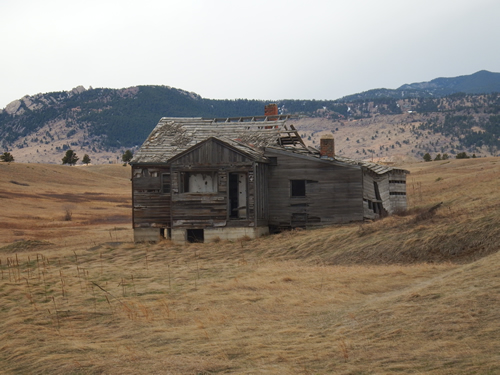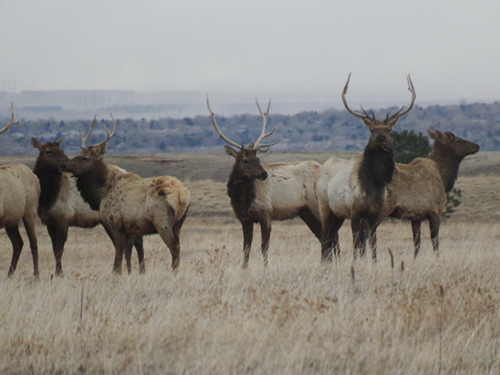Rocky Flats National Wildlife Refuge
Overview
 The Rocky Flats National Wildlife Refuge (Refuge) was established in 2007 and is managed by the U.S. Fish and Wildlife Service (Service).
The Rocky Flats National Wildlife Refuge (Refuge) was established in 2007 and is managed by the U.S. Fish and Wildlife Service (Service).
This 5,000-acre Refuge has striking vistas of the Front Range of the Rocky Mountains and rolling prairie grasslands, woodlands and wetlands. It is home to 239 migratory and resident wildlife species, including prairie falcons, deer, elk, coyotes, songbirds, and the federally threatened Preble’s meadow jumping mouse.
Large areas of the Refuge have remained relatively undisturbed for the last 30 to 50 years resulting in diverse habitat and wildlife. A portion of the Refuge contains rare xeric tallgrass prairie, providing habitat for a variety of wildlife and serving as an important natural and conservation resource.
The Refuge is located 16 miles northwest of Denver, Colorado, and is bordered by Boulder, Broomfield and Jefferson counties. The site is surrounded by urban development to the northeast and southeast, and expansive open space to the north, east and west, providing a protected corridor for migrating wildlife.
Rocky Flats National Wildlife Refuge opened 10.3 miles of trails to visitors on Saturday, September 15, 2018. Visitors can enjoy these trails open year round for wildlife viewing, photography, and to connect with nature. Designated Refuge trails are open for hiking, bicycling, cross country skiing, snowshoeing, and horseback riding.
 Refuge trails meander through mixed and tallgrass prairie. Trail surfaces are crushed gravel or dirt. To protect wildlife and habitat, visitor access is limited to designated trails and roads only. All other Refuge lands and staff roads are closed to visitor entry. When visiting the Refuge, please keep the following rules in mind: Observe all posted signs and regulations; Park only in designated areas; Assistance dogs are welcome and must be on a leash at all times. All other pets are prohibited.
Refuge trails meander through mixed and tallgrass prairie. Trail surfaces are crushed gravel or dirt. To protect wildlife and habitat, visitor access is limited to designated trails and roads only. All other Refuge lands and staff roads are closed to visitor entry. When visiting the Refuge, please keep the following rules in mind: Observe all posted signs and regulations; Park only in designated areas; Assistance dogs are welcome and must be on a leash at all times. All other pets are prohibited.
The Refuge’s main entrance is located at mile marker 3 on the south side of Highway 128. There is a gravel parking lot for vehicles and horse trailers. The Refuge is open from sunrise to sunset seven days a week (closed on Thanksgiving, Christmas Day, and New Year’s Day only). For more information please call the Colorado Front Range National Wildlife Refuge Complex at 303-289-0930.For more information, please visit https://www.fws.gov/refuge/rocky_flats/
This 5,237-acre Refuge is home to 239 migratory and resident wildlife species including prairie falcon, mule and white-tailed deer, elk, coyotes, songbirds, hawks, and the federally threatened Preble’s meadow jumping mouse. Over 630 species of plants and a variety of wildflowers bloom here spring through fall. Xeric tallgrass prairie habitat is found on the Refuge, one of the largest remaining areas of this globally rare ecosystem.
Read a recent article about hiking at Rocky Flats here.
Purpose
The Refuge’s purpose is to restore and preserve native ecosystems, which will in turn provide habitat for migratory and resident wildlife. Specific habitat management practices for the federally threatened Preble’s meadow jumping mouse will not only benefit this species but other species depend on riparian and wetland habitat for survival. In the future, the Refuge will provide environmental education, nature programs, and wildlife-focused visitor opportunities.
Management and Restoration
Refuge staff use a variety of management and restoration techniques to enhance, restore, and monitor wildlife and habitat on our National Wildlife Refuges. Prescribed burns, biological controls, and mowing ensure a healthy and sustainable ecosystem.
Invasive weeds present a tremendous challenge to the health and diversity of native plants and wildlife habitat on the Refuge. They can outcompete native plants resulting in poor habitat for wildlife. They also can spread to adjacent lands and cause significant problems for our neighbors. The predominant invasive weeds are diffuse knapweed, Dalmatian toadflax, and Canada thistle. Herbicides, biological controls, mechanical removal, prescribed burns, and controlled grazing are management tools used to control the spread of and reduce these weed species. Refuge staff work with adjacent land owners and local agencies to coordinate weed management activities.
Site History
Native Americans occupied the land intermittently prior to the 1800s and limited artifacts have been located from this era. Starting in 1868, the Scott family established a homestead here and the land was used to raise cattle. The Lindsay family raised cattle and built a house and barn in the 1940s. In 1951, the U.S. Atomic Energy Commission acquired 2,519 acres, which included the Lindsay property, for the Rocky Flats (RF) Plant to produce nuclear and nonnuclear EVweapons including plutonium triggers for nuclear weapons. An additional 4,027 acres were acquired in 1974 for plant expansion.
This site was one of 13 nuclear weapons production facilities in the United States during the Cold War and was managed by the Department of Energy (DOE). The plant operated from 1952 to 1994 with manufacturing activities taking place in the center portion of the site with a large buffer zone around the area.
The site was added to the Environmental Protection Agency’s (EPA) National Priorities List (Superfund List) in 1989. The facility’s mission changed from production to cleanup and closure and was renamed the Rocky Flats Environmental Technology Site. Through the Rocky Flats Act of 2001, the site was established as a national wildlife refuge while cleanup was underway. With oversight from the EPA and Colorado Department of Public Health and the Environment, the DOE completed the $7 billion cleanup in 2005. The DOE maintains 1,300 acres as part of their legacy management for long-term site maintenance and to ensure the cleanup is functioning as designed. These lands are not part of the Refuge.
Today, the Refuge supports an abundance of resident and migratory wildlife. The Refuge is one of over 560 refuges in the National Wildlife Refuge System – a network of lands set aside and managed by the U.S. Fish and Wildlife Service specifically for wildlife. The Refuge System is a living heritage, conserving wildlife and habitat for people today and for generations to come.




